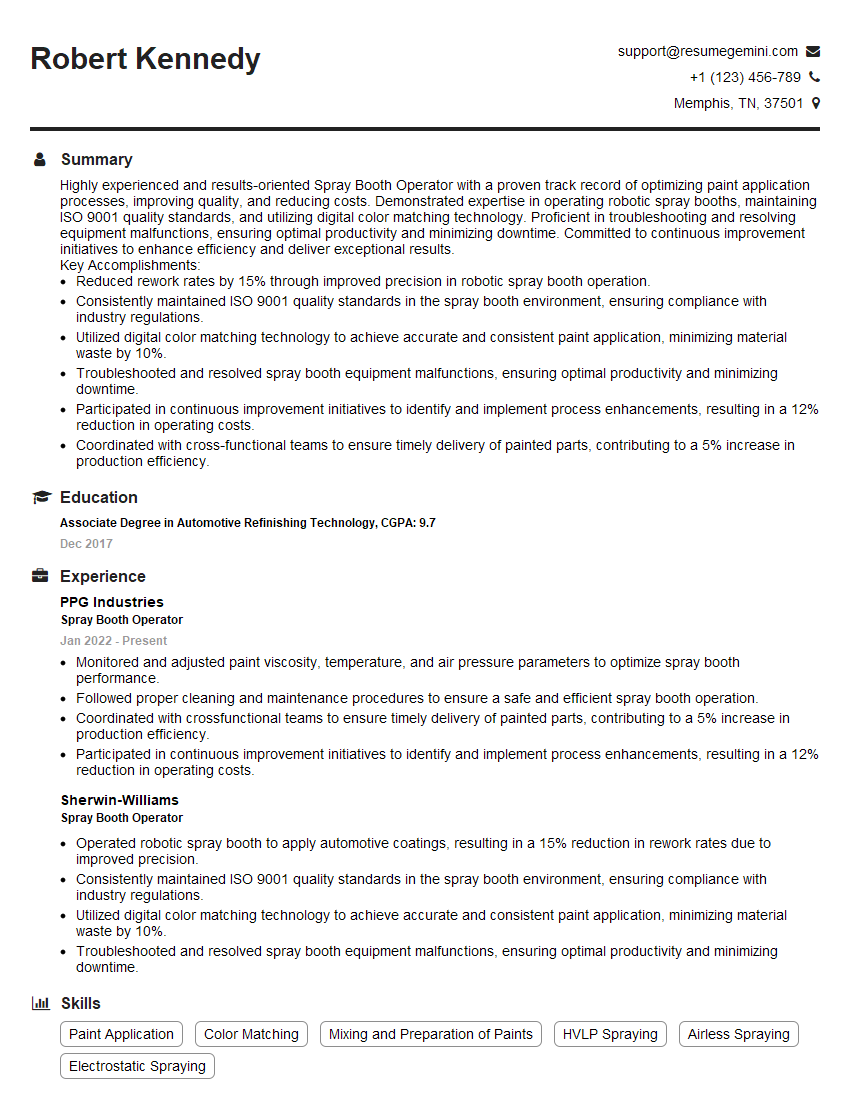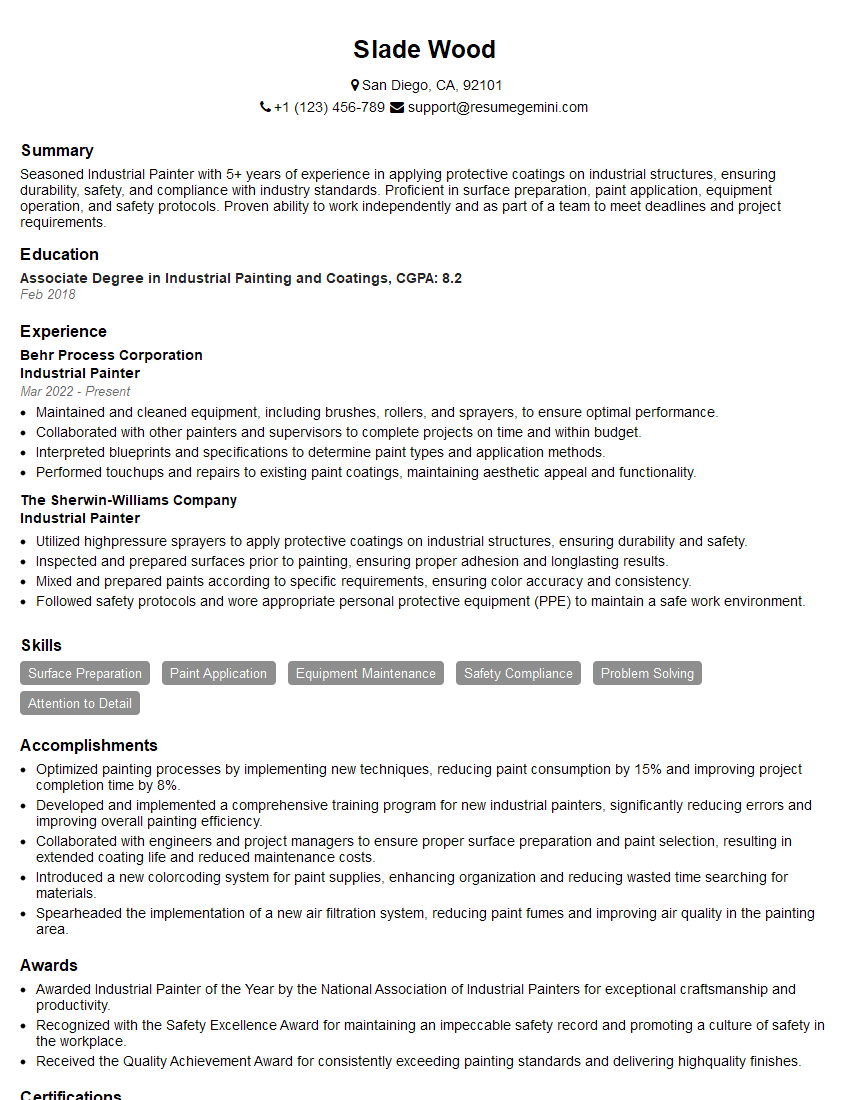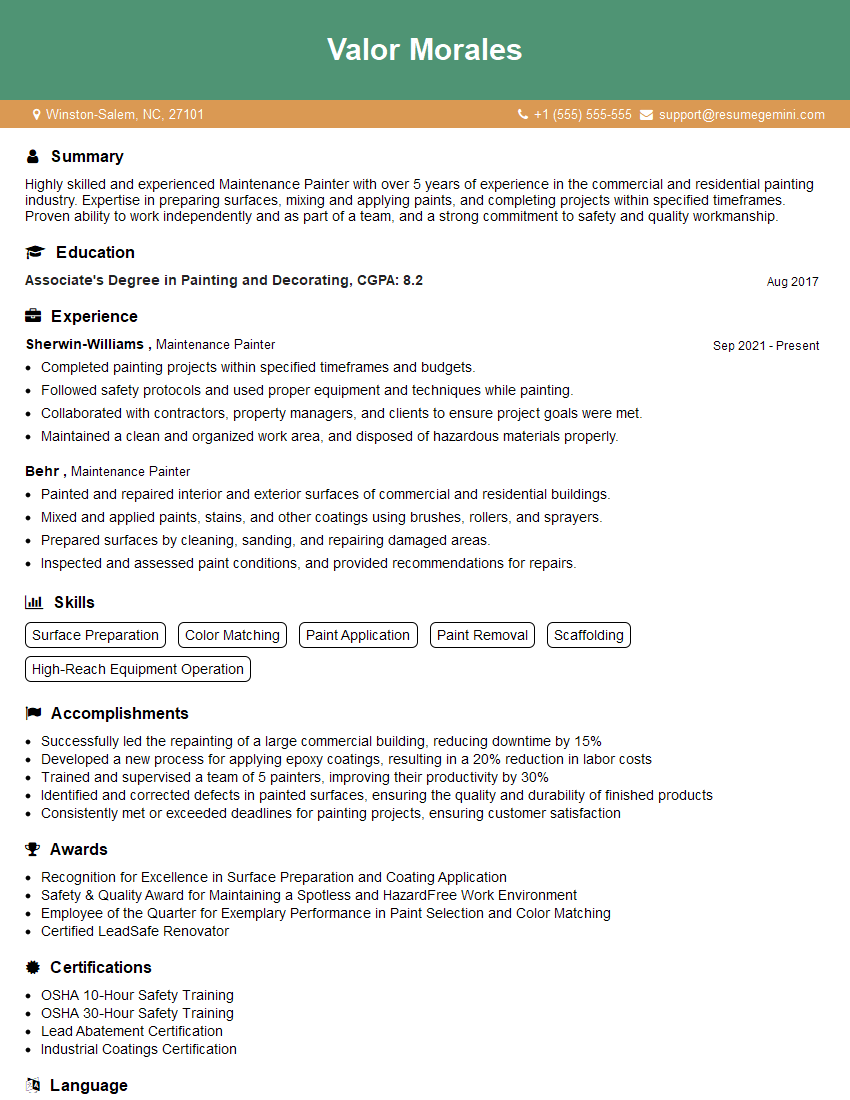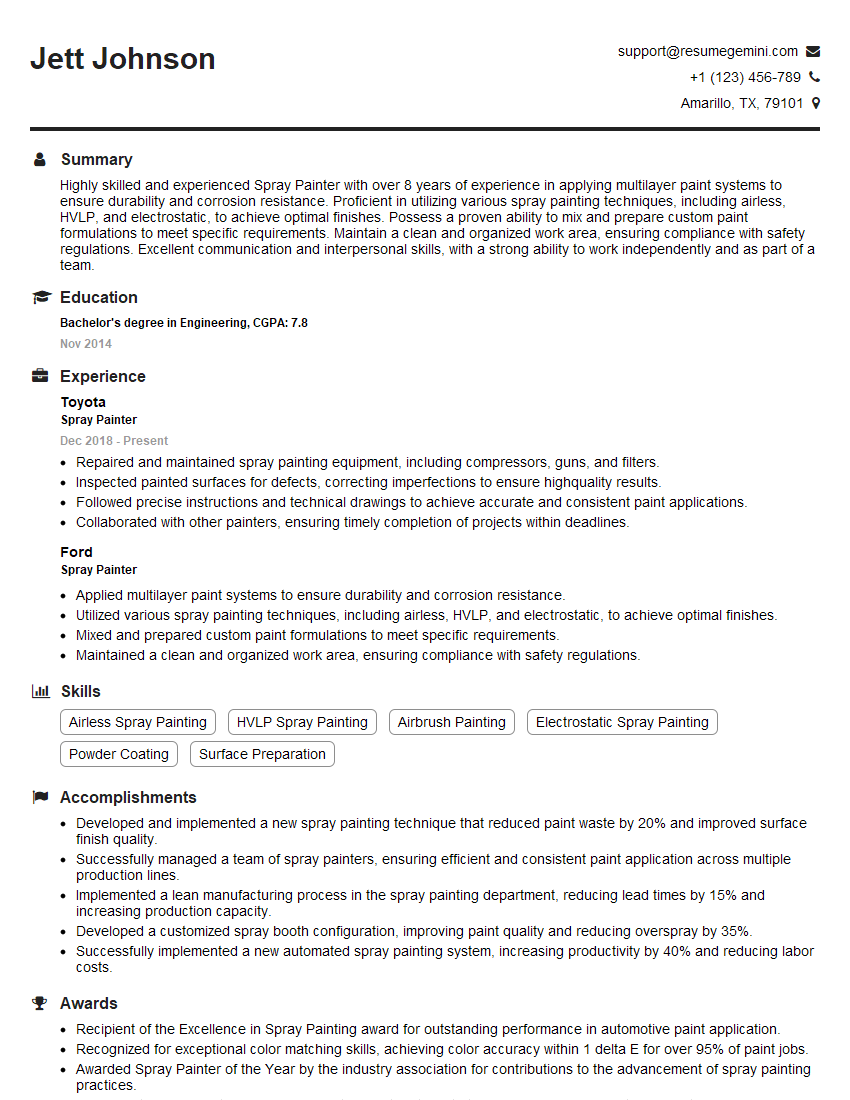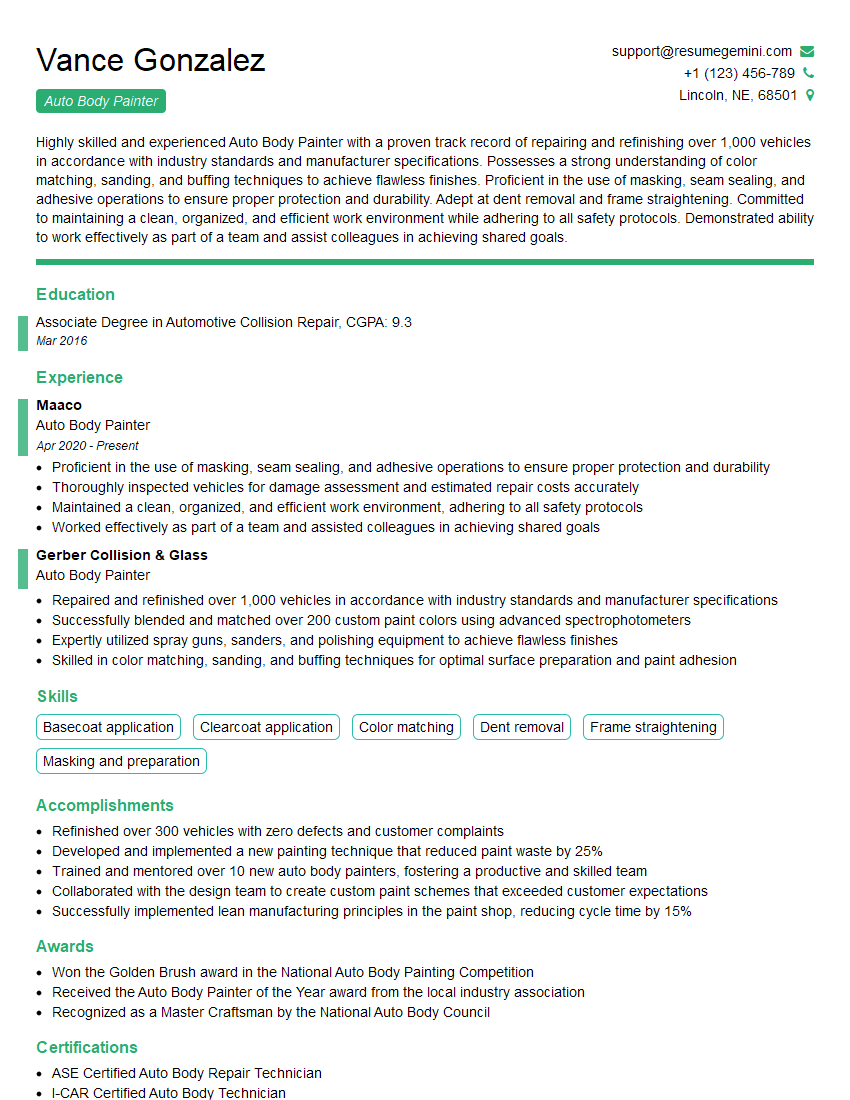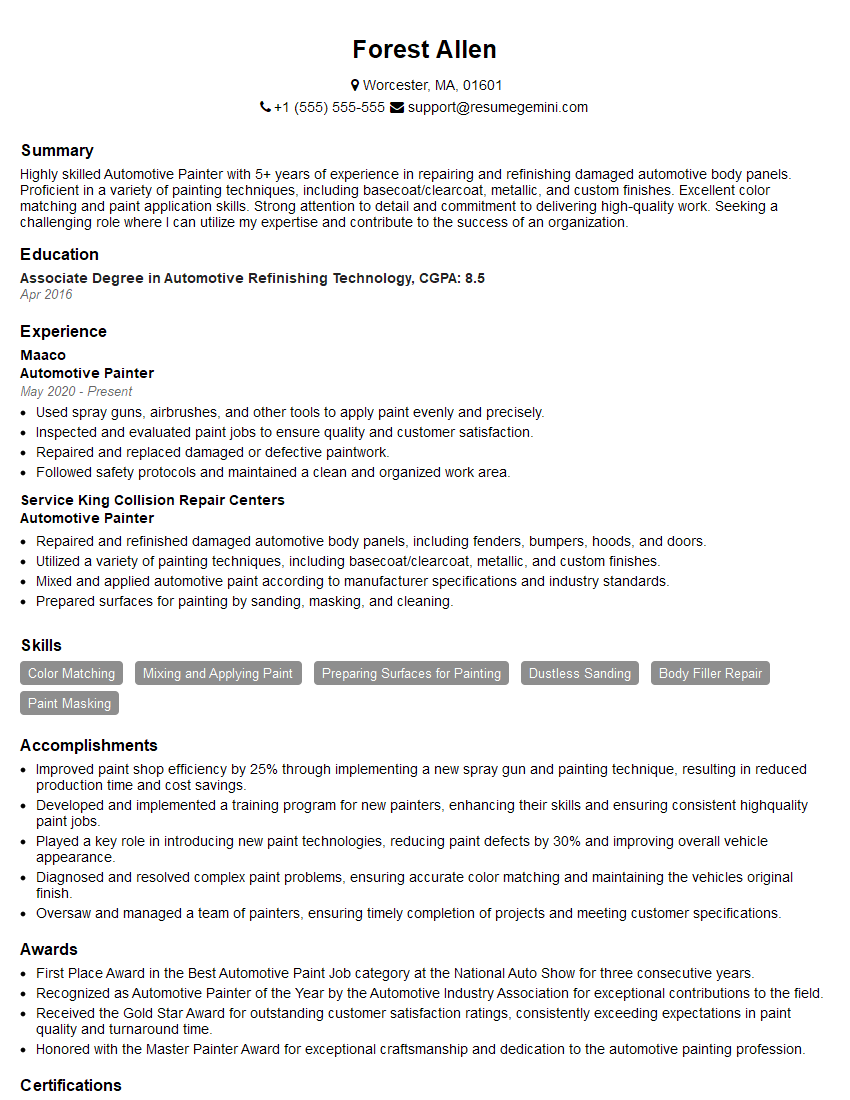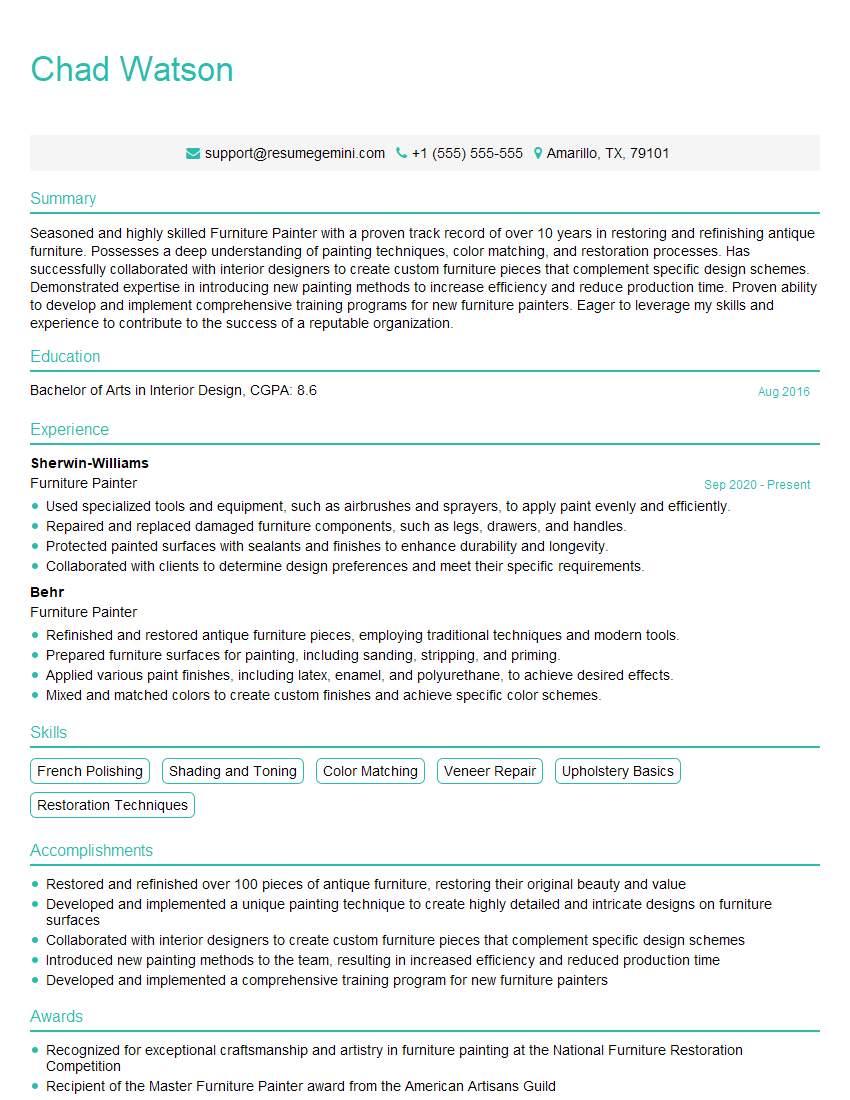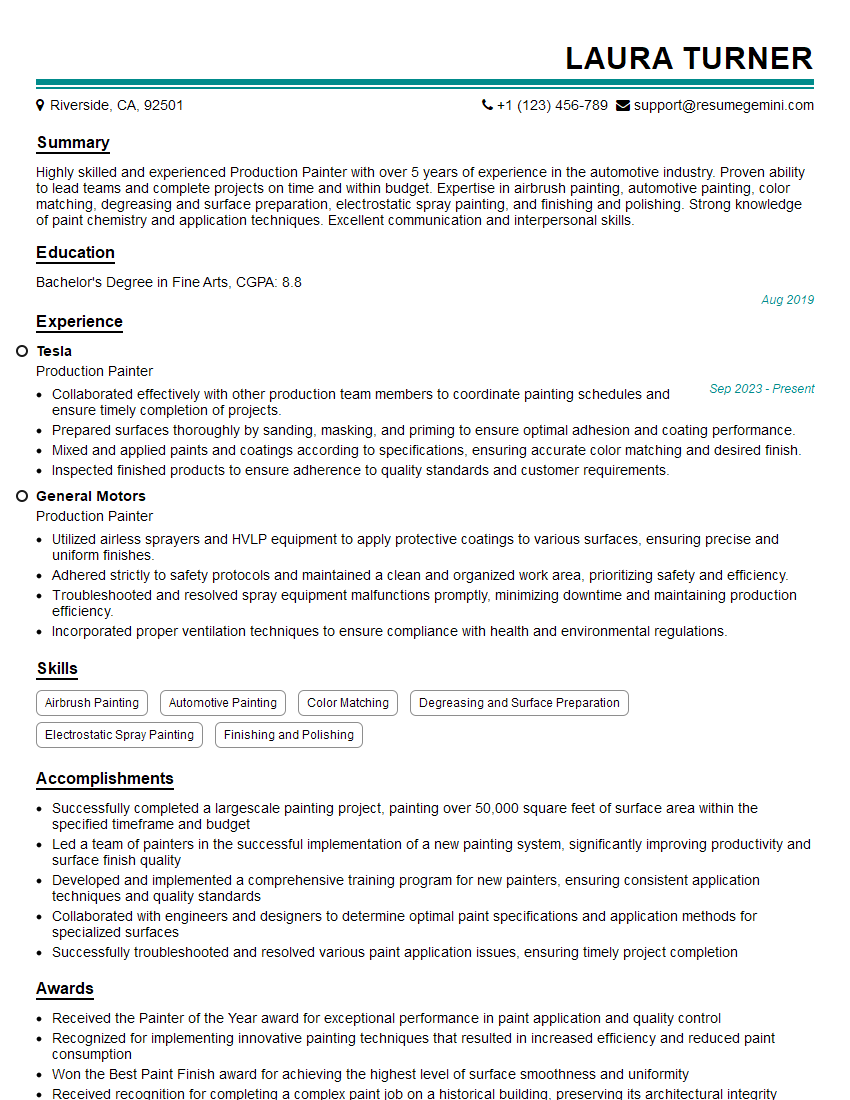Interviews are more than just a Q&A session—they’re a chance to prove your worth. This blog dives into essential Paint Sprayer Operation interview questions and expert tips to help you align your answers with what hiring managers are looking for. Start preparing to shine!
Questions Asked in Paint Sprayer Operation Interview
Q 1. What types of paint sprayers are you familiar with (e.g., HVLP, airless, electrostatic)?
I’m proficient with several types of paint sprayers, each suited to different applications. The three main categories I work with are:
- HVLP (High Volume Low Pressure): These sprayers use a large volume of air at low pressure to atomize the paint. They are known for their efficiency, minimizing overspray and reducing waste. This is perfect for detailed work and fine finishes, especially when working with delicate materials or in environments where overspray is a major concern. I’ve used them extensively on furniture refinishing projects, achieving a smooth, even coat.
- Airless Sprayers: Airless sprayers utilize extremely high pressure to atomize the paint without the need for a large volume of compressed air. They’re ideal for large-scale projects like painting houses or fences due to their speed and ability to handle heavy-bodied paints. The trade-off is that they produce more overspray than HVLP systems, making proper surface preparation crucial.
- Electrostatic Sprayers: These sprayers charge the paint particles, causing them to be attracted to the grounded surface. This improves transfer efficiency, reducing paint waste and minimizing overspray even further. They are particularly useful for painting complex shapes or hard-to-reach areas and are commonly used in industrial settings. I’ve used them for specialized applications requiring precise coating.
Q 2. Describe your experience with different paint types (e.g., lacquer, enamel, acrylic)?
My experience spans a variety of paint types. Each requires a different approach regarding sprayer settings and cleaning procedures. Here are some examples:
- Lacquer: Fast-drying and requiring a quick, even application. I use lower pressures and thinner coats to prevent runs and drips. Requires careful ventilation due to strong fumes.
- Enamel: A durable, high-gloss paint that requires a slightly higher pressure setting to ensure proper atomization. Cleaning is more thorough due to its thicker consistency. Perfect for long-lasting finishes on cabinetry or trim.
- Acrylic: A water-based paint that is easy to clean up. I often use HVLP sprayers with acrylic paints because of their low overspray characteristic, reducing cleanup time. Great for interior walls and other large surface areas.
Understanding the properties of each paint type is crucial to achieve the desired finish.
Q 3. Explain the process of preparing a surface for painting.
Surface preparation is paramount for a professional paint job. Skipping this step almost guarantees a subpar result. The process generally involves these steps:
- Cleaning: Removing dirt, grease, dust, and any loose paint with a suitable cleaner and scraper. A pressure washer can be useful for exterior surfaces.
- Repairing: Filling any holes, cracks, or imperfections with appropriate fillers and allowing ample drying time. This often involves sanding to a smooth finish.
- Sanding: Smoothing out any uneven surfaces using progressively finer grit sandpaper. This ensures good adhesion and a uniform finish.
- Priming (if necessary): Applying a primer to seal the surface, improve paint adhesion, and provide a consistent base color. The type of primer depends on the substrate and paint being used.
- Masking: Protecting areas you don’t want to paint using painter’s tape and drop cloths. This is essential for neat lines and prevents accidental overspray.
Thorough surface preparation saves time and materials in the long run by ensuring the paint adheres properly and looks its best.
Q 4. How do you maintain and clean different types of paint sprayers?
Maintaining and cleaning sprayers is essential to prolong their lifespan and prevent clogging. The process varies depending on the sprayer type and the paint used:
- HVLP: Requires thorough cleaning with appropriate solvents or water (for water-based paints) after each use. Disassembling certain parts often helps ensure thorough cleaning.
- Airless: These usually involve flushing the system with a specialized cleaning solution and then running a thinner through to remove residual paint. The pump needs regular lubrication.
- Electrostatic: Cleaning procedures vary depending on the specific model. Consult the manufacturer’s instructions for proper cleaning and maintenance.
Regular maintenance, including checking for leaks and ensuring proper lubrication, prevents problems and maximizes the lifespan of the equipment. Ignoring cleaning can lead to clogged nozzles, poor finishes and ultimately, costly repairs.
Q 5. What safety precautions do you follow when operating a paint sprayer?
Safety is my top priority. When operating a paint sprayer, I always:
- Wear appropriate personal protective equipment (PPE): This includes a respirator to prevent inhaling paint fumes, safety glasses to protect my eyes, and gloves to protect my skin. A full face shield is recommended for many applications.
- Work in a well-ventilated area: Paint fumes can be harmful, so adequate ventilation is essential. Consider using respirators with appropriate filters for the paint being used.
- Follow manufacturer’s instructions: Each sprayer has its own safety guidelines that must be followed.
- Be aware of surroundings: Ensure there are no flammable materials nearby when working with solvents.
- Maintain proper distance from the surface: This prevents runs and provides an even coat. Excessive proximity can lead to damage.
Safety is not just a guideline; it’s a fundamental aspect of my work, preventing accidents and ensuring a healthy work environment.
Q 6. How do you troubleshoot common paint sprayer problems (e.g., clogging, spitting)?
Troubleshooting is a crucial skill. Here’s how I handle common problems:
- Clogging: This is often caused by dried paint in the nozzle or fluid lines. Thorough cleaning with the appropriate solvent or water, and sometimes disassembling and cleaning the nozzle, is necessary. Using a thinner paint or properly thinning the paint before spraying can help prevent clogging.
- Spitting: This usually indicates air in the paint line, a faulty nozzle, or a low paint level. Check for air leaks, replace the nozzle if necessary, and ensure the paint container is full.
- Uneven spray pattern: This can be due to incorrect pressure settings, a worn nozzle, or a clogged filter. Adjust the pressure according to the paint type and manufacturer’s guidelines, replace the nozzle or clean the filter.
Systematic troubleshooting involves identifying the symptom, checking the potential causes, and then systematically eliminating them. Preventive maintenance significantly reduces the frequency of these issues.
Q 7. What is your experience with different spray techniques (e.g., fanning, overlapping)?
Mastering spray techniques is key to achieving a professional finish. I use a combination of techniques:
- Fanning: Creating a broad, even coat by moving the sprayer in a controlled side-to-side motion. The width of the fan needs to be adjusted based on the size of the surface and the type of sprayer being used.
- Overlapping: Slightly overlapping each pass to ensure a consistent, even coat without leaving unpainted areas. The degree of overlap depends on the paint and sprayer. The key is not to allow one section to dry before the next layer is applied so as to avoid visible lines.
- Wet-on-wet technique: Applying multiple thin coats, allowing each coat to remain wet before applying the next. This creates a smooth, even finish without visible brush strokes or laps.
Practice is essential to develop a consistent and proficient spray technique. Consistent speed, distance, and overlapping are vital for high quality results.
Q 8. How do you achieve a uniform paint finish?
Achieving a uniform paint finish with a paint sprayer hinges on several key factors, all working in harmony. Think of it like baking a cake – if one ingredient is off, the whole thing suffers. Consistency is paramount.
- Consistent Spray Distance: Maintaining a consistent distance between the sprayer nozzle and the surface is crucial. Too close, and you risk runs and drips; too far, and the finish will be uneven and patchy. Imagine trying to water your garden with a hose – too close and you drown the plants, too far and they barely get watered. A good rule of thumb is to maintain a distance of 6-12 inches, depending on the nozzle size and paint type.
- Even Spray Pattern Overlap: Overlapping each pass by about 50% ensures a smooth, even coat. Imagine painting a wall with a roller – you wouldn’t leave gaps, right? The same principle applies here. Avoid sudden stops and starts to prevent noticeable overlaps or streaks.
- Proper Spray Technique: Move the sprayer smoothly and at a consistent speed, using a side-to-side motion. Avoid lingering in one spot. This is best learned through practice, much like learning to write neatly.
- Appropriate Paint Viscosity: The paint’s thickness (viscosity) is key. Too thick, and you’ll get a heavy, uneven coat; too thin, and you’ll get an excessively thin and possibly patchy finish. We’ll discuss viscosity in more detail below.
- Clean Equipment: A clean sprayer is essential for an even finish. Clogged nozzles or dirty fluid lines will lead to inconsistent paint flow and a poor finish.
By mastering these techniques, you can ensure a professional, uniform finish every time.
Q 9. How do you determine the appropriate paint viscosity for different surfaces?
Determining the appropriate paint viscosity is vital for a successful paint job. Viscosity refers to the thickness or resistance to flow of a liquid. It’s adjusted using thinners or reducers, and the correct viscosity depends on several factors, including the type of paint, the surface being sprayed, and the sprayer’s settings.
- Surface Type: Porous surfaces like wood absorb more paint, requiring a slightly thicker viscosity to prevent it from drying too quickly. Non-porous surfaces like metal may require a thinner viscosity to prevent runs and sags. Think of it like trying to paint a sponge versus a glass plate – the sponge will soak up more paint.
- Paint Type: Different paint types have different ideal viscosities. Acrylic paints, for example, often require less thinning than alkyd paints. Always consult the manufacturer’s instructions for recommended viscosity.
- Environmental Conditions: Temperature and humidity can affect viscosity. Hot and dry conditions cause paint to dry faster, potentially requiring a slightly thicker viscosity. Conversely, cooler and more humid conditions might require a thinner viscosity to allow for adequate flow.
- Testing Viscosity: The best way to determine the right viscosity is through a simple test. Spray a small amount of paint onto a test surface and observe the flow and drying time. Adjust the viscosity as needed.
Often, a simple viscosity cup is used to measure the time it takes for a certain amount of paint to flow through an orifice – comparing this time against manufacturer recommendations helps dial in the ideal viscosity for a given job.
Q 10. Explain the importance of proper ventilation in a spray booth.
Proper ventilation in a spray booth is absolutely critical for both worker safety and the quality of the paint finish. Overspray, solvent fumes, and fine paint particles can be extremely hazardous if inhaled. Good ventilation removes these airborne contaminants.
- Health Risks: Many paints and coatings contain volatile organic compounds (VOCs), which are harmful if inhaled. Proper ventilation reduces the concentration of VOCs to safe levels, protecting the painter’s respiratory system.
- Fire Hazards: Paint overspray can be flammable, especially in the presence of sparks or open flames. Adequate ventilation minimizes the risk of fire by removing flammable vapors.
- Paint Finish Quality: Dust and other airborne contaminants can settle on wet paint, resulting in a poor-quality finish. A well-ventilated spray booth helps minimize these problems.
- Regulatory Compliance: Many jurisdictions have regulations regarding ventilation in spray painting areas. Compliance is crucial to avoid penalties and ensure a safe work environment.
In short, proper ventilation in a spray booth is not just a good idea; it’s a necessity for health, safety, and a superior paint finish.
Q 11. What is your experience with air pressure regulation and adjustments?
Air pressure regulation is fundamental to successful paint spraying. Incorrect air pressure leads to a variety of problems, from poor atomization to excessive overspray.
- Air Pressure Gauges: Accurate air pressure gauges are essential for monitoring and adjusting air pressure. I always double-check the gauge readings and ensure they are calibrated.
- Pressure Regulators: Pressure regulators allow fine-tuning of the air pressure delivered to the paint sprayer. This precise control enables optimization for different paint types, nozzle sizes and surface areas.
- Troubleshooting: If the finish is uneven, orange peel, or has excessive overspray, adjusting the air pressure is often the first step in troubleshooting. For instance, if the finish is too heavy, I’ll reduce the air pressure slightly. If the finish is too thin or patchy, I’ll increase air pressure.
- Experience: Years of experience have taught me how to quickly adjust pressure to suit different scenarios. It’s not just about numbers; it’s about understanding how pressure interacts with paint viscosity, nozzle size and material type.
Mastering air pressure regulation is a key skill that separates an amateur from a professional painter.
Q 12. How do you manage paint waste and disposal?
Managing paint waste and disposal is crucial for environmental protection and regulatory compliance. It’s not just about throwing things away; it’s about responsible waste management.
- Minimize Waste: Accurate estimation of paint needs and careful spraying techniques help minimize waste. Proper planning is key.
- Proper Containment: Use appropriate containers to collect overspray and leftover paint. Spills should be cleaned immediately and disposed of properly.
- Recycling and Disposal: Many paint manufacturers offer recycling programs for used paint. Alternatively, follow local regulations for the proper disposal of hazardous waste.
- Clean-up Procedures: Establish efficient clean-up procedures to prevent the accumulation of paint waste and reduce the environmental impact.
- Documentation: Maintaining detailed records of paint usage and disposal is essential for compliance.
Responsible paint waste management is not just a legal requirement; it’s an ethical responsibility to protect our environment.
Q 13. Describe your experience with different nozzle sizes and their applications.
Nozzle size selection directly impacts the spray pattern and the quality of the paint finish. Different nozzle sizes are suited to different applications.
- Small Nozzles (e.g., 1.0mm – 1.4mm): These are ideal for detailed work, intricate designs, and areas requiring precise paint application, like car trim or fine furniture.
- Medium Nozzles (e.g., 1.5mm – 1.8mm): These are versatile and commonly used for general-purpose applications, such as painting walls, fences, or larger furniture items. They provide a balance of detail and coverage.
- Large Nozzles (e.g., 2.0mm+): These are suitable for large areas requiring rapid coverage, such as painting houses or large industrial equipment. However, they may lack precision.
- Material Considerations: The material of the nozzle also influences its performance. High-quality, wear-resistant nozzles provide a longer lifespan and consistent spray.
Choosing the correct nozzle is like selecting the right tool for a specific task. A small nozzle is not ideal for painting a large wall, just as a large nozzle isn’t appropriate for fine detailing.
Q 14. What is your understanding of different paint application methods (e.g., single-stage, two-stage)?
Different paint application methods cater to different needs and desired finishes.
- Single-Stage Application: This method involves applying a single coat of paint that combines color and clear coat in one. It’s efficient but may offer less durability and gloss compared to two-stage.
- Two-Stage Application: This method involves applying a base coat of color followed by a clear coat. The clear coat enhances the gloss, durability, and protection of the paint job. It’s more time-consuming but results in a higher quality finish, often seen in automotive painting.
- Considerations: The choice between single-stage and two-stage depends on factors such as the desired finish, the substrate being painted, and budget considerations. Two-stage is more common in situations where longevity and a high-quality gloss are important.
Imagine single-stage as applying a tinted sunscreen, offering some protection and color. Two-stage is more akin to applying a base layer of sunscreen, followed by a protective layer with higher sun protection factor (SPF), providing greater and more lasting protection.
Q 15. How do you handle different surface textures when spraying paint?
Handling different surface textures when spray painting requires adapting your technique to achieve a uniform finish. Rough surfaces require a wetter coat and potentially a lower air pressure to ensure adequate paint penetration into the crevices. Conversely, smooth surfaces benefit from a slightly higher air pressure and a thinner coat to avoid runs and sags. Think of it like watering a garden – you use a gentler spray for delicate seedlings and a stronger spray for established plants.
- Rough Surfaces (e.g., wood with a coarse grain, stucco): Use a lower air pressure, a slightly wetter coat (adjusting the fluid viscosity accordingly), and multiple thinner passes instead of one heavy coat. This ensures paint reaches all the crevices and avoids build-up in the raised areas.
- Smooth Surfaces (e.g., metal, primed drywall): Higher air pressure can be used here along with a more controlled spray pattern. Thinner coats applied at a consistent distance prevent runs and ensure a smooth finish.
- Textured Surfaces (e.g., orange peel texture): In this case, the technique needs to match the existing texture. You may need to slightly adjust your spray distance and pressure to ensure consistency and avoid uneven coverage.
In every case, a test spray on a hidden area is always recommended to ensure the settings work well with your paint and surface.
Career Expert Tips:
- Ace those interviews! Prepare effectively by reviewing the Top 50 Most Common Interview Questions on ResumeGemini.
- Navigate your job search with confidence! Explore a wide range of Career Tips on ResumeGemini. Learn about common challenges and recommendations to overcome them.
- Craft the perfect resume! Master the Art of Resume Writing with ResumeGemini’s guide. Showcase your unique qualifications and achievements effectively.
- Don’t miss out on holiday savings! Build your dream resume with ResumeGemini’s ATS optimized templates.
Q 16. How do you control the spray pattern and distance from the surface?
Controlling the spray pattern and distance is crucial for achieving a professional finish. This is primarily managed through the spray gun’s controls (air pressure, fluid flow, fan width adjustment) and your hand movement. The distance you maintain is directly related to the width of the spray pattern and the evenness of the paint film.
- Spray Pattern: Most spray guns allow you to adjust the fan width from a narrow stream to a wide fan. Narrow patterns are ideal for precise work, like edges and tight corners, while wider patterns work best for larger surfaces. Always overlap each pass by about 50% to avoid visible streaks.
- Distance: The ideal distance typically ranges between 6-12 inches, depending on the gun, paint viscosity, and surface. Experimenting on a test piece helps determine this. Too close results in runs and sags, while too far can create a dry spray, leading to an uneven finish (similar to what you’d get when spraying an aerosol can too far from the target).
- Hand Movement: Maintain a smooth, consistent, and even pace during spraying. Avoid sudden stops and starts, and keep your hand moving at all times within the spray. The movement should be almost effortless like you are tracing the surface.
Consider using masking techniques in conjunction with spray control to produce a clean, crisp outcome for areas where precision is key, such as around trim or window frames.
Q 17. Describe your experience with masking techniques and protective measures.
Masking and protective measures are paramount for a clean and efficient spray painting job. Proper masking prevents overspray and protects surfaces you don’t want painted. This can dramatically reduce cleanup time.
- Masking Tape: Use high-quality painter’s tape to mask off areas you want to protect. Apply it carefully and firmly to prevent paint bleed-through. Different tapes work better with different paints and surfaces, so use appropriate tapes.
- Drop Cloths: A heavy-duty drop cloth is essential to protect the floor and any other surfaces that may be exposed to overspray. Consider using plastic sheeting underneath to provide an additional barrier and then covering with the drop cloths.
- Protective Gear: Personal protective equipment (PPE) is critical. This includes respirators (for both solvents and dust), safety glasses, gloves, and long-sleeved clothing to protect your skin and respiratory system from paint fumes and overspray.
For instance, when painting interior trim, I meticulously mask the walls, floor and any surrounding areas. Proper preparation often determines the quality of the final result, and proper protective measures safeguard the environment and your health.
Q 18. How do you identify and correct paint defects (e.g., runs, sags, orange peel)?
Identifying and correcting paint defects is a crucial part of the process, showcasing attention to detail and the ability to resolve issues promptly. Common defects include runs, sags, and orange peel.
- Runs and Sags: These are usually caused by excessive paint buildup or incorrect spray technique (too close to the surface, too much paint, or slow hand movement). Correcting them involves carefully removing the excess paint using a putty knife or scraper (when the paint is still wet) and then re-spraying the area thinly and evenly.
- Orange Peel: This texture resembles the skin of an orange and is often caused by insufficient paint atomization, too high air pressure, or the paint being too dry. It can be mitigated by using a slightly lower air pressure, using a slightly wetter coat, and increasing the distance from the surface. Sometimes sanding and re-spraying may be needed.
- Dry Spray: Too much air pressure, being too far from the surface, or too thin of a coat can lead to a dry spray. This is characterized by a grainy and uneven finish. Correcting this involves re-spraying the area after assessing the cause of the issue.
Prevention is key, so maintaining proper technique throughout the job is important. However, knowing how to address common problems makes the final product professional.
Q 19. What is your experience with color matching and mixing?
Color matching and mixing requires accuracy and precision, as a slight error can significantly impact the final result. My experience includes using both computerized color matching systems and traditional methods.
- Computerized Systems: These systems use spectrophotometers to analyze the color of an existing paint sample and provide a precise formula for matching it. This is very efficient and typically yields accurate results.
- Traditional Methods: This involves manually mixing paints using a color chart and tint bases. It requires knowledge of color theory and a good eye for accurate proportions and adjustments.
I have successfully matched a variety of colors for projects ranging from automotive repainting to residential interior work. Accuracy here means making adjustments as needed and knowing when it is appropriate to make minor corrections. It’s both an art and a science!
Q 20. Describe your experience with different types of spray guns and their features.
My experience encompasses a variety of spray guns, including HVLP (High Volume Low Pressure), conventional, and airless spray guns. Each type has its advantages and disadvantages.
- HVLP: These are known for their high transfer efficiency (less overspray), making them environmentally friendly and economical. They’re suitable for smaller projects and offer fine control, but the lower pressure means longer spraying times.
- Conventional: These are more widely used and provide good control, but their transfer efficiency is lower, leading to more overspray. They’re a good option for many tasks and typically have a balance of control and speed.
- Airless: These are used for larger projects, such as painting houses or large industrial equipment. They apply paint quickly with high pressure, but require careful technique to avoid runs and sags. The high pressure can also lead to more overspray if not used carefully.
Choosing the right spray gun depends on the project size, surface area, paint type, and desired finish. I always consider the material’s viscosity, the environmental considerations, and the overall efficiency and outcome.
Q 21. What is your understanding of the environmental regulations related to paint spraying?
Understanding and complying with environmental regulations related to paint spraying is essential. These regulations aim to minimize air pollution and protect the environment. My understanding includes awareness of VOC (Volatile Organic Compound) limits, proper disposal of paint waste, and the use of appropriate ventilation systems.
- VOC Limits: Many regions have regulations restricting the amount of VOCs in paints and coatings. Choosing low-VOC paints is crucial in compliance. Knowing the local regulations and compliance standards is absolutely critical.
- Waste Disposal: Paint and cleaning solvents should be disposed of properly in accordance with local regulations. Improper disposal contributes significantly to environmental pollution. This often requires knowing and following your local municipality’s mandates.
- Ventilation: Proper ventilation is key to ensuring worker safety and compliance. This involves using respirators, ensuring proper air circulation in the spray area, and potentially using specialized ventilation equipment to capture paint overspray.
Staying informed on current regulations and best practices is an ongoing process. Responsible paint spraying involves protecting the environment and human health, as much as it does achieving a great finish.
Q 22. How do you maintain consistent paint flow during spraying?
Maintaining consistent paint flow is crucial for achieving a smooth, even finish. It involves a multi-faceted approach, focusing on the paint itself, the sprayer settings, and the spraying technique.
- Paint Viscosity: The paint’s thickness (viscosity) is paramount. Too thick, and it will spray unevenly, resulting in drips and runs. Too thin, and you’ll get a patchy, translucent finish. Using the appropriate thinner or reducer, according to the manufacturer’s instructions for the paint and sprayer, is key. I always check the viscosity using a Zahn cup or similar tool to ensure consistency throughout the project.
- Air Pressure and Fluid Adjustment: Your paint sprayer has controls to regulate both air pressure and the amount of paint flowing through the nozzle. These need careful adjustment, often requiring experimentation to find the sweet spot for each paint type and substrate. I typically start with the manufacturer’s recommended settings as a baseline and then fine-tune based on the results. For example, higher air pressure can lead to finer atomization but might also result in overspray, whereas a lower pressure might create a heavier coat with potential for runs.
- Spray Technique: Consistent overlapping passes and maintaining a constant distance from the surface are crucial. Think of it like mowing a lawn – you overlap each pass to avoid leaving gaps. I use a smooth, even motion, keeping my hand and arm steady to prevent variations in paint application. The speed of the pass is also a factor; too slow, and you’ll get runs; too fast, and the finish might be too light.
- Sprayer Maintenance: A clean and properly maintained sprayer is essential. Clogged nozzles or a faulty air cap can significantly impact paint flow. Regular cleaning, including flushing the system with thinner after each use, prevents blockages. I also regularly inspect the nozzle and air cap for wear and tear and replace them as needed.
For instance, on a recent project painting a large metal gate, I carefully measured the paint viscosity with a Zahn cup, adjusted the air pressure and fluid flow according to the paint manufacturer’s guidelines for the type of paint and my sprayer, and practiced consistent overlapping passes at a uniform distance to achieve a professional, even finish.
Q 23. What is your experience with using a spray booth and its controls?
I have extensive experience working within spray booths of various sizes and complexities. My experience encompasses understanding and utilizing their various controls to optimize the painting process and ensure a safe working environment.
- Ventilation and Airflow: I understand the importance of proper ventilation in removing overspray and airborne paint particles, preventing both respiratory issues and fire hazards. I’m familiar with operating and monitoring the booth’s ventilation system, ensuring sufficient airflow and proper extraction. I know how to check and maintain filters for optimal performance.
- Lighting and Visibility: Adequate lighting is essential for inspecting the surface and ensuring even paint application. I always ensure the spray booth lighting is sufficient and well-maintained, allowing for clear visibility of the work surface.
- Environmental Controls: Many modern spray booths have controls for temperature and humidity. I understand how these factors can affect the drying and curing process of the paint and how to adjust the booth’s environment to optimize the finish. For example, high humidity can slow down drying and lead to imperfections.
- Safety Features: I’m trained to use and maintain all safety features within the spray booth, including emergency shut-off switches, fire suppression systems, and air filtration systems. I always conduct pre-work safety checks to ensure everything is functioning correctly before starting work.
For example, during a large-scale automotive painting project, I utilized the spray booth’s advanced controls to adjust the airflow and temperature to achieve the ideal painting environment while ensuring the safety and efficiency of the process. I meticulously monitored air quality, ensuring efficient removal of overspray.
Q 24. Describe your experience working with different types of substrates (e.g., wood, metal, plastic).
My experience includes working with a wide range of substrates, each requiring a slightly different approach to achieve optimal results.
- Wood: Wood requires careful surface preparation, including sanding and priming, to ensure proper adhesion of the paint. The type of wood and its finish also influence paint selection and application techniques. I’ve worked with everything from fine furniture to rough-sawn lumber, adjusting my techniques accordingly. For example, a porous wood like pine might require multiple coats of primer to prevent bleed-through.
- Metal: Metal surfaces often require cleaning, degreasing, and possibly rust removal before painting. The choice of paint will depend on the type of metal and its intended use. For instance, automotive paints offer superior durability on car parts, while a different type might be more suitable for outdoor metal furniture exposed to weathering.
- Plastic: Plastic surfaces can be challenging because of their varied compositions and tendency to repel paint. Proper surface preparation, sometimes involving a special primer or adhesion promoter, is critical for a durable finish. I’ve worked with different types of plastics, adjusting my approach based on their properties.
In one project, I painted a set of antique wooden chairs and a metal garden gate. For the chairs, I used a specialized wood primer and paint for superior adhesion and a smooth finish. The metal gate required a rust-preventative primer before applying the chosen paint for long-lasting protection.
Q 25. How do you ensure the safety of yourself and others when working in a spray booth?
Safety is my top priority in a spray booth environment. This involves understanding and adhering to strict safety procedures and utilizing appropriate protective measures.
- Ventilation: Ensuring proper ventilation is paramount to remove overspray and airborne particles, minimizing exposure to hazardous materials. I always verify that the spray booth’s ventilation system is functioning correctly before starting work.
- Fire Prevention: Spray painting involves flammable materials; therefore, I always follow strict protocols regarding fire prevention. This includes keeping the area clean, using proper fire suppression systems, and avoiding any ignition sources.
- PPE Use: I consistently and correctly use all necessary PPE, including respirators, safety glasses, gloves, and coveralls. I always select appropriate PPE for the specific paint being used. I regularly inspect my PPE to ensure its condition is optimal for safety.
- Emergency Procedures: I am familiar with and trained on emergency procedures specific to spray booth operations, including how to respond to spills, fires, or other emergencies. I know the location of all emergency equipment and the evacuation plan.
A recent incident highlighted this importance. A small fire erupted in the spray booth (due to an equipment malfunction); however, my swift response in activating the booth’s fire suppression system quickly contained it, preventing damage and injury. This underscores the necessity of preparedness and adherence to safety protocol.
Q 26. What is your understanding of different paint curing processes?
Paint curing is the process by which the applied paint film hardens and becomes resistant to damage. Different paints use different curing mechanisms, influenced by factors such as paint chemistry, temperature, and humidity.
- Air Drying: This is the simplest method, where the paint solvent evaporates, leaving behind a solid film. This is common for many water-based paints.
- Forced Air Drying: This speeds up the air drying process using fans or other forced airflow systems. This is common in spray booths to accelerate drying and reduce project time.
- Oven Curing (Baking): This involves exposing the painted surface to elevated temperatures in a specialized oven, accelerating the chemical reactions within the paint and creating a very durable finish. This is common in industrial settings for automotive or appliance painting.
- UV Curing: Certain paints use UV light to initiate rapid curing, providing a very fast and highly durable finish. UV curing is used in specialized applications such as screen printing and certain industrial coatings.
Understanding the curing process is crucial. For instance, if you apply an oven-cured paint and leave it to air dry, the finish might not be durable. In my experience, I’ve adjusted my approach based on the paint’s curing requirements, using forced air drying in the booth or oven curing in specialized industrial settings for optimal results.
Q 27. Describe your experience with using personal protective equipment (PPE) while spray painting.
Using the correct PPE is non-negotiable when spray painting. My experience encompasses the selection, use, and maintenance of various PPE items to protect myself from harmful exposure to chemicals and overspray.
- Respirators: I always use an appropriate respirator, selecting the type based on the paint’s specific hazards (e.g., organic vapor, particulate matter). I ensure the respirator fits properly and is maintained correctly for optimal protection. Regular filter changes are critical.
- Safety Glasses/Goggles: Protecting my eyes from overspray and paint splashes is paramount. I consistently wear safety glasses or goggles, ensuring they provide adequate protection. I regularly inspect them for damage before commencing work.
- Gloves: The type of gloves worn depends on the paint and solvents used, but it’s always a necessity. I select chemically resistant gloves suited to the specific materials I’m using, ensuring they’re in good condition and replaced as needed.
- Coveralls or Protective Clothing: Full-body protection is crucial to prevent paint from contacting my skin. I wear coveralls or protective clothing that provide adequate coverage. I regularly inspect and replace damaged or worn clothing.
I remember a project where we were using a particularly harsh solvent-based paint. I made sure to select a respirator with the correct cartridges, along with chemical-resistant gloves and coveralls. Using proper PPE ensures not only my safety but the safety of my colleagues working alongside me.
Key Topics to Learn for Paint Sprayer Operation Interview
- Understanding Paint Sprayer Types: Familiarize yourself with different sprayer types (HVLP, airless, electrostatic) and their applications. Consider the advantages and disadvantages of each for various projects.
- Safety Procedures and Regulations: Mastering safety protocols is paramount. Understand the handling of hazardous materials (paints, solvents), proper PPE use, and emergency procedures. Be prepared to discuss relevant OSHA or industry-specific regulations.
- Paint Preparation and Application Techniques: Learn about mixing paint to the correct consistency, surface preparation (cleaning, sanding, priming), and various spray techniques (wet-on-wet, overlapping passes) to achieve a high-quality finish. Discuss different spray patterns and their uses.
- Troubleshooting and Maintenance: Gain practical knowledge of identifying and resolving common issues such as nozzle clogging, uneven spraying, and equipment malfunctions. Be prepared to describe routine maintenance tasks.
- Surface Preparation and Material Knowledge: Understanding different surface types (wood, metal, plastic) and selecting the appropriate paint and preparation techniques is crucial. Discuss the properties of different paint types and their suitability for various applications.
- Quality Control and Inspection: Learn about inspecting finished work for defects, such as runs, sags, orange peel, and pinholes. Describe methods for ensuring a consistent and high-quality finish.
- Environmental Considerations: Understand environmentally friendly practices, waste disposal methods, and the impact of paint spray operations on the environment. Be aware of VOC regulations and best practices for minimizing environmental impact.
Next Steps
Mastering Paint Sprayer Operation opens doors to a rewarding career with excellent growth potential. Your expertise in this skilled trade is highly sought after, leading to diverse opportunities and potentially higher earning potential. To maximize your job prospects, a well-crafted, ATS-friendly resume is essential. ResumeGemini is a trusted resource that can significantly enhance your resume-building experience, making your qualifications stand out to potential employers. Examples of resumes tailored to Paint Sprayer Operation are available to help you create a winning application.
Explore more articles
Users Rating of Our Blogs
Share Your Experience
We value your feedback! Please rate our content and share your thoughts (optional).
What Readers Say About Our Blog
good
